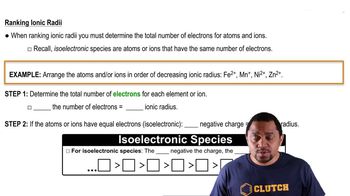Here are the essential concepts you must grasp in order to answer the question correctly.
Bond Length
Bond length is the distance between the nuclei of two bonded atoms. It is influenced by the size of the atoms involved and the type of bond (single, double, etc.). Understanding bond lengths helps predict molecular geometry and reactivity, as shorter bonds typically indicate stronger interactions.
Recommended video:
Atomic Radii
Atomic radii refer to the size of an atom, typically measured from the nucleus to the outermost electron shell. These values vary across the periodic table and are crucial for estimating bond lengths in compounds. The effective atomic radius can change depending on the bonding environment and the type of atoms involved.
Recommended video:
Molecular Geometry
Molecular geometry describes the three-dimensional arrangement of atoms within a molecule. It is determined by the number of bonds and lone pairs around the central atom, influencing properties like polarity and reactivity. Understanding molecular geometry is essential for predicting bond lengths and angles in compounds like AsCl3.
Recommended video:
Molecular Geometry with Two Electron Groups




